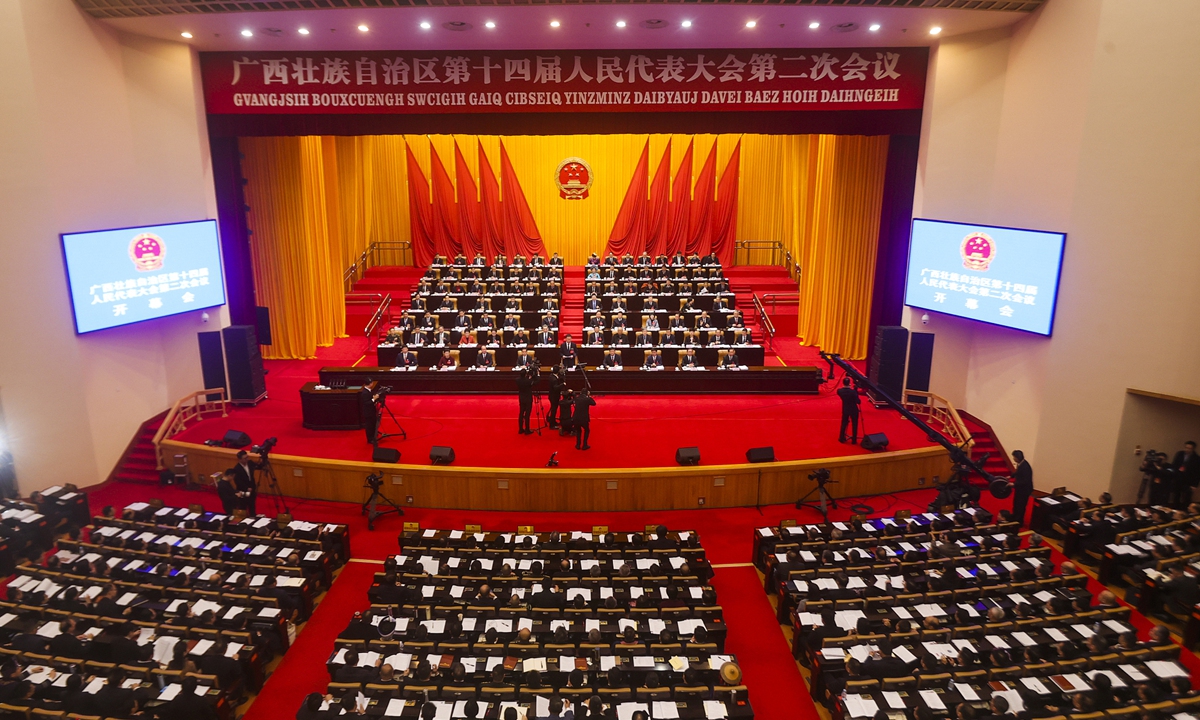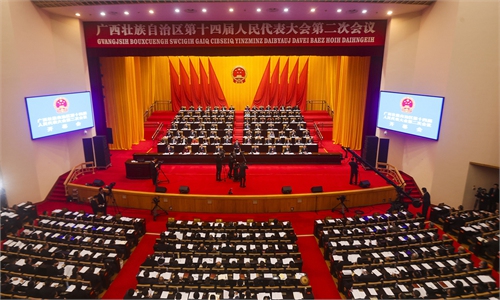
The 2024 local two sessions starts in Nanning, South China's Guangxi Zhuang Autonomous Region on January 22, 2024. Photo: Xinhua
Chinese provinces, autonomous regions, and municipalities recently convened their local "two sessions," with provincial-level lawmakers and political advisors putting forward a number of proposals to contribute to encouraging larger families in the face of low population growth.
Luo Haining, a member of the Tianjin Committee of the Chinese People's Political Consultative Conference (CPPCC), proposed to include preschool education under the age of three within the scope of social public services.
Luo said that under the influence of traditional concepts, care of infants under the age of three has always been regarded as a private family matter, and the responsibility is mainly borne by the mother or other female elders. Adding preschool education as one of social public services would relieve the dual pressure of women finding suitable childcare and returning to work after giving birth.
Liu Dejun, a political advisor from Shandong Province also submitted a proposal relating to optimization of the childcare service system. To reverse the current situation of low fertility, both comprehensive and precise efforts are required.
This year's local "two sessions" come at a time when the country population has declined for two years in a row. China's population decreased by 2.08 million people in 2023 to 1.40967 billion, National Bureau of Statistics (NBS) data released on January 17 showed. In 2023, 9.02 million babies were born, resulting in a birth rate of 6.39 per thousand people. Meanwhile, 11.1 million people died in 2023, equal to a death rate of 7.87 per thousand people, the data showed.
Ouyang An, a CPPCC member from Jiangxi Province, and chief obstetrician at Jiangxi Maternal and Child Health Hospital, proposed to the Civil Affairs Department of Jiangxi to increase pre-marital trainings and pre-pregnancy education when couples are booking marriage registration.
Ouyang told the Global Times on Thursday that he found many newlyweds do not know how to get along with each other, often leading to communication problems and even divorce. Pre-marital training would contribute to the country's population growth, he stated.
Song Jian, a demographer from the Center for Population and Development Studies of the Renmin University of China, said in China marriage is a precondition for having children thus how resources are allocated within one family will have direct impact on their family planning decision.
In Shanghai, the city's Women's Federation submitted eight proposals to the city's two sessions covering a broad range of components, such as women's employment, protection of children's rights and interests, and women's development.
One of the highlights is a proposal calling for providing a certain proportion of social security subsidies to employers to reduce the additional economic burden caused by female workers and emphasizing that it is necessary to distinguish the different subsidy policies formulated by female workers to encourage having larger families.
The Women's Federation also suggested companies to adopt flexible working hours to female workers and offer rewards for those companies that employ female workers.
Yuan Xin, deputy head of the China Population Association and a demographer from Nankai University, told the Global Times that proposals made by lawmakers and political advisors are essential for the country to explore more feasible fertility support policies. But Yuan also emphasized the necessity of building more comprehensive and unified fertility support policies that are based on different regions.
A comprehensive fertility support policy should be further optimized across areas including policy support, time support, technology support, as well as creating social atmosphere for families to have more children, Yuan noted.
The latest China Development Report 2023 released by the State Council's Development Research Center pointed out that over the past 12 years, China has experienced two significant turning points in terms of population, the peak of the working-age population and the peak of the total population. Currently, China's total population is at its peak, and it is expected to continue declining for the foreseeable future.
Yuan said despite negative population growth, policymakers shouldn't overact, in the middle of this century, China will still be one of the two 'billion-level' populous countries in the world, with a population of about 1.2-1.4 billion.


